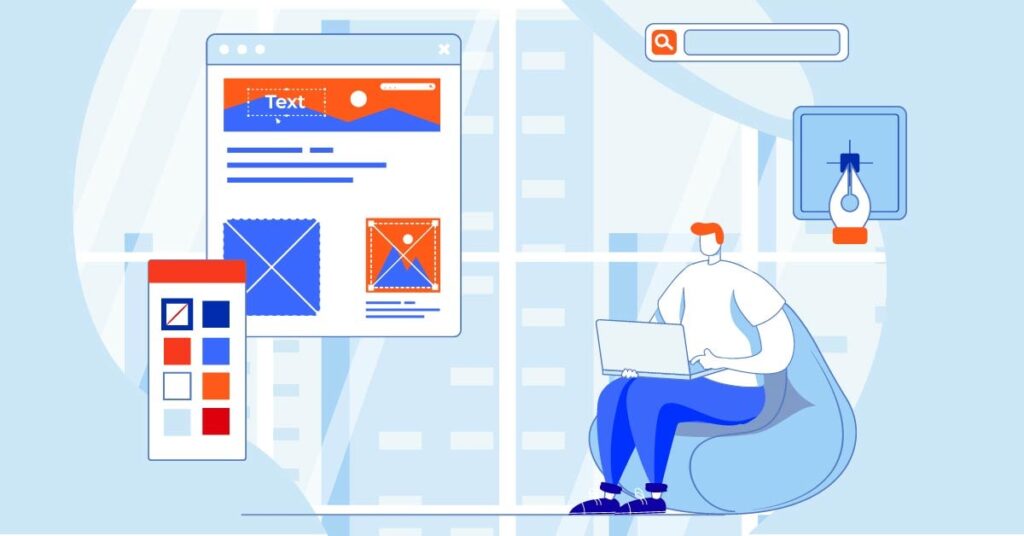
Minimalist web design turns overwhelming, cluttered interfaces into sleek, clear sense purposeful digital spaces. By focusing on simplicity and clarity, good minimalist web design prioritises what truly matters—helping users engage effortlessly with content.
At its core, minimalist design strips away the noise. Every element has a role, every choice is intentional. Clean layouts and intuitive navigation ensure users stay focused and satisfied. It’s not about having less for the sake of it; it’s about creating more impact with fewer distractions.
When content takes centre stage, the experience feels natural and refined. A thoughtfully designed minimalist website doesn’t just look good—it resonates. It influences how users perceive your brand, leaving a lasting impression.
Understanding Minimalism in Web Design

Minimalist web design is a design philosophy that emphasizes simplicity and the removal of unnecessary elements. A minimalist web design definition highlights the principle of ‘less is more,’ focusing on reducing elements to enhance user experience without compromising functionality.
It focuses on clean lines, ample white space, and a limited, neutral color palette to create a streamlined and efficient user experience. By prioritizing essential content and eliminating distractions, minimalist web design aims to improve usability and readability.
Minimal website design enhances user experience by facilitating easy browsing and navigation bar creating a visually appealing layout that focuses on essential content without unnecessary distractions.
Definition and Key Elements of Minimalist Web Design
Minimalist web design is a style that emphasizes simplicity, clarity, and functionality. It’s characterized by a limited color palette, a primary focus on typography, and the use of negative space to create a clean and uncluttered visual aesthetic.
This design style leverages negative space as a defining characteristic, enhancing simplicity and visual contrast, which significantly contributes to the overall aesthetic of web pages. The key elements of minimalist web design include:
A Limited Color Palette: Minimalist websites often use a monochromatic or muted color scheme to create a sense of cohesion and simplicity. This approach ensures that the design feels unified and focused, allowing the content to take center stage.
A Focus on Typography: Typography is a crucial element in minimalist web design. Using simple, easy-to-read sans serif fonts helps communicate the most important information clearly and effectively. Consistent typography enhances readability and maintains a professional look.
Use of Negative Space: Also known as white space, negative space is essential in minimalist web design. It provides breathing room for the content, making it stand out and improving overall readability. Ample white space creates a balanced and harmonious layout.
Focus on Functionality: Minimalist websites prioritize functionality and usability. By removing unnecessary elements, the design ensures that site visitors can easily find what they need. This focus on user experience makes navigation intuitive and efficient.
Core Principles of Minimal Web Design
Simplicity
Simplicity is the heartbeat of minimalist web design. By removing unnecessary elements, the design allows content to breathe. Navigation feels effortless, and users engage without distractions. This clarity reduces cognitive load, creating an experience that feels intentional and polished.
Functionality
Minimalism isn’t just about aesthetics—it’s about usability. Every element serves a specific purpose. From intuitive navigation to functional buttons, a minimalist website prioritises user needs. By simplifying interfaces, designers enhance efficiency without sacrificing experience.
Historical Context
Origins of Minimalism
Minimalism began as an art movement focused on simplicity, clarity, and purpose. Over time, it influenced architecture and product design, where “less is more” became the golden rule. This philosophy laid the foundation for modern web design, emphasising form and function.
Evolution in Web Design
Early websites were cluttered and chaotic. As the internet evolved, designers recognised the need for simplicity. Minimalist web design emerged as a solution, reducing visual noise and creating streamlined, elegant experiences. Today, it’s a cornerstone of modern design, balancing aesthetics with functionality.
Benefits of Minimalist Web Design

Minimalist web designs are a key design principle that enhances user experience. They emphasize simplicity in navigation and the dramatic effects that can be achieved through subtle animations and careful use of photography, typography, and contrast, while maintaining a minimalist aesthetic.
Enhanced User Experience
Faster Load Times
Minimalist web design is fast by nature. Fewer elements mean lighter pages, which load quickly and efficiently. Users appreciate this instant access, leading to a smoother, frustration-free experience.
Improved Navigation
Simplified navigation makes exploring a minimalist website effortless. Clean menus and clear pathways guide users intuitively to the next page links and content they need. The result? An experience that feels natural, efficient, and enjoyable.
Focused Content
Minimalist design highlights what matters most—your content. By removing distractions, it draws users’ attention to key messages, ensuring communication is clear, concise, and impactful.
Reduced Distractions
Clutter-free layouts create a calm, focused environment. Users can engage without competing visuals or excessive information. By incorporating only a few elements, designers can simplify responsiveness and enhance user experience on mobile devices. This intentional simplicity enhances retention and encourages meaningful interactions.
Why Choose a Minimalist Website Design
Minimalist website design is a popular choice for many businesses and individuals due to its numerous benefits. Here are some compelling reasons to choose a minimalist website design:
Improved User Experience
Minimalist websites are often easier to navigate and understand. The clean and straightforward design helps site visitors find what they need quickly and effortlessly, enhancing their overall experience.
Increased Focus on Content
By removing unnecessary elements, minimalist websites draw attention to the most important content. This focused approach ensures that key messages are communicated clearly and effectively.
Faster Load Times
With fewer elements to load, minimalist websites often have faster load times. This speed improvement not only enhances the user experience but also positively impacts search engine rankings.
Minimalist websites are typically more mobile-friendly. The simplified design adapts well to various screen sizes, ensuring that site visitors have a seamless experience across all devices.
Best Practices for Minimalist Design

For those looking to delve deeper into minimalist graphic design, exploring minimalist website design examples can be incredibly insightful. The arrangement and selection of visual elements play a crucial role in this context, influencing user experience and the intuitiveness of web pages.
These examples showcase how simplicity in digital design can enhance both aesthetics and functionality, providing inspiration and practical ideas for your own projects.
Use of White Space
Creating Balance
White space isn’t “empty”—it’s functional. It guides the user’s eye, creates balance, and enhances clarity. Well-placed white space makes content shine while keeping layouts clean and polished.
Highlighting Key Elements
Strategic use of white space ensures essential elements stand out against white background. Whether it’s a call-to-action, a headline, or visuals, users’ focus is directed naturally, making interactions seamless and impactful.
Typography and Colour
Choosing Fonts
Typography influences how users perceive and engage with a site. Clean, readable fonts aligned with brand identity ensure a professional look. Consistent typography keeps the design cohesive while enhancing usability.
Colour Schemes
Minimalist designs rely on limited palettes. Simple, well-chosen colours amplify emotions, guide user focus, and create harmony. With fewer colours doing more, the design feels intentional and refined.
The Role of White Space in Minimalist Web Design
White space, also known as negative space, is a crucial element in minimalist web design. It refers to the empty space between and around design elements, such as text, images, and buttons. White space plays a vital role in creating a clean, simple, and visually appealing design.
Importance of White Space in Minimalist Web Design
White space is essential in minimalist web design because it:
Creates a Clear Visual Hierarchy: White space helps to separate design elements and create a clear visual hierarchy, making it easier for users to focus on the most important content.
Improves Readability: White space makes text more readable by reducing clutter and creating a clear distinction between different blocks of text.
Enhances User Experience: White space can help to reduce cognitive load and make the website feel more spacious and breathable, leading to a better user experience.
Supports Minimalist Aesthetic: White space is a key element in creating a minimalist aesthetic, as it helps to remove clutter and focus on the essential elements.
How to Effectively Use White Space in Web Design
To effectively use white space in web design, follow these tips:
Use White Space to Create a Clear Visual Hierarchy: Use white space to separate design elements and create a clear visual hierarchy.
Balance White Space with Content: Make sure to balance white space with content to avoid making the website feel too empty or too cluttered.
Use White Space to Create a Sense of Flow: Use white space to create a sense of flow and guide the user’s eye through the website.
Experiment with Different Types of White Space: Experiment with different types of white space, such as micro white space (small gaps between elements) and macro white space (larger gaps between sections).
Creating a Minimalist Website
Creating a simple website designs for a minimalist website requires a thoughtful and intentional approach to design. Here are the steps to create a minimalist website design:
Steps to Create a Minimalist Website Design
Define Your Goals and Target Audience: Before starting the design process, define your goals and target audience to ensure that your website meets their needs.
Simplify Your Content: Simplify your content by removing unnecessary words, images, and other elements that don’t support your goals.
Choose a Simple Color Palette: Choose a simple color palette that supports your brand and is easy on the eyes.
Select Clean Typography: Select clean typography that is easy to read and supports your brand.
Use White Space Effectively: Use white space effectively to create a clear visual hierarchy, improve readability, and enhance user experience.
Remove Unnecessary Design Elements: Remove unnecessary design elements, such as cluttered navigation, excessive images, and unnecessary animations.
Test and Iterate: Test your website with real users and iterate on the design based on feedback and user testing results.
By following these steps and tips, you can create a minimalist website and landing page that is clean, simple, and visually appealing, and that supports your goals and target audience.
Elements of Minimalist Web Design

Negative Space
Negative space, or white space, is a fundamental element of minimalist web design. It refers to the empty space between and around elements on a web page. Effective use of negative space can significantly enhance the design by:
Improving Readability
Ample white space makes it easier for site visitors to read and understand the content. It reduces visual clutter and allows the text to breathe, enhancing overall readability.
Creating Balance
Negative space helps create a sense of balance and harmony on a web page. It ensures that the design feels cohesive and well-organized, making the user experience more enjoyable.
Drawing Attention to Important Elements
By strategically using negative space, minimalist websites can draw attention to the most important elements on the page. This focus ensures that key messages and calls-to-action stand out.
High-Quality Images
High-quality images play a crucial role in minimalist web design. They can enhance the visual appeal of home page of a website and contribute to a more engaging user experience by:
Adding Visual Interest
High-quality images can break up text and add visual interest to a web page. They make the design more dynamic and engaging, capturing the attention of site visitors.
Communicating Information
Images can be powerful tools for communicating information. They can help site visitors understand complex concepts quickly and effectively, complementing the textual content.
Creating a Sense of Atmosphere
Images can set the tone and mood of a web page. By choosing images that align with the brand’s identity and message, designers can create a cohesive and immersive experience for site visitors.
By incorporating these elements, minimalist web design creates a clean, functional, and visually appealing experience that resonates with users and leaves a lasting impression.
Tools and Resources for Minimalist Website Design

Design Software
Popular Tools
Tools like Adobe XD, Sketch, and Figma empower designers to create clean, impactful designs. Web templates further streamline workflows, ensuring efficiency without compromising quality.
Features to Look For
When choosing tools, prioritise:
Responsive design for multi-device adaptability.
User-friendly interfaces to simplify workflows.
Prototyping options to test interactions.
Tool integrations for a seamless process.
Online Resources
Tutorials
Platforms like YouTube and Coursera offer guides and courses that simplify mastering minimalist design principles, from beginner basics to advanced techniques.
Inspiration Galleries
Websites like Behance and Dribbble showcase stunning minimalist design examples, sparking creativity and helping designers stay in tune with emerging trends.
Common Mistakes to Avoid
Over-Simplification
Minimalism doesn’t mean removing everything. Stripping away essential features can frustrate users. Keep functionality intact and ensure the design serves its purpose seamlessly.
Lack of Content
Minimalist doesn’t mean empty. Users still need enough information to make decisions. Provide clear, concise content that informs without overwhelming.
Ignoring User Needs
Accessibility is non-negotiable. Add alt text, ensure keyboard navigation, and design for all abilities. Usability should always guide decisions—test with real users to identify pain points early. A minimalist website design example can illustrate how different websites effectively utilize empty white space surrounding them, striking imagery, and minimal text to draw attention to their content.
Future of Minimalist Web Design

Emerging Trends
Integration of AI
AI personalises user experiences, streamlines workflows, and enhances functionality. Features like chatbots and AI-driven analytics make websites smarter without adding visual clutter.
Responsive Design Innovations
Responsive design is evolving, with mobile-first approaches, fluid grids, and flexible visuals ensuring seamless experiences across all devices. Consistency is key to user satisfaction.
Technological Advancements
Impact on Design
New tools and technologies, like VR, AR, and high-speed media content, are redefining user expectations. Designers are blending minimalism with innovation to deliver immersive yet simple experiences.
Opportunities for Innovation
From voice interfaces to blockchain, opportunities abound for pushing minimalist design further. The challenge—and opportunity—is to innovate while keeping simplicity and functionality at the core.
Conclusion
Minimalist web design is about creating more impact with less noise. By prioritising simplicity, functionality, and clarity, it transforms cluttered interfaces into sleek, intentional digital experiences.
From faster load times and improved usability to emerging AI trends, minimalism remains a timeless approach with room to grow. When a minimal design is done right, it doesn’t just look good—it resonates.
If you’re a web designer, ready to simplify and make your content shine, minimalism is the key to achieving maximum impact.




